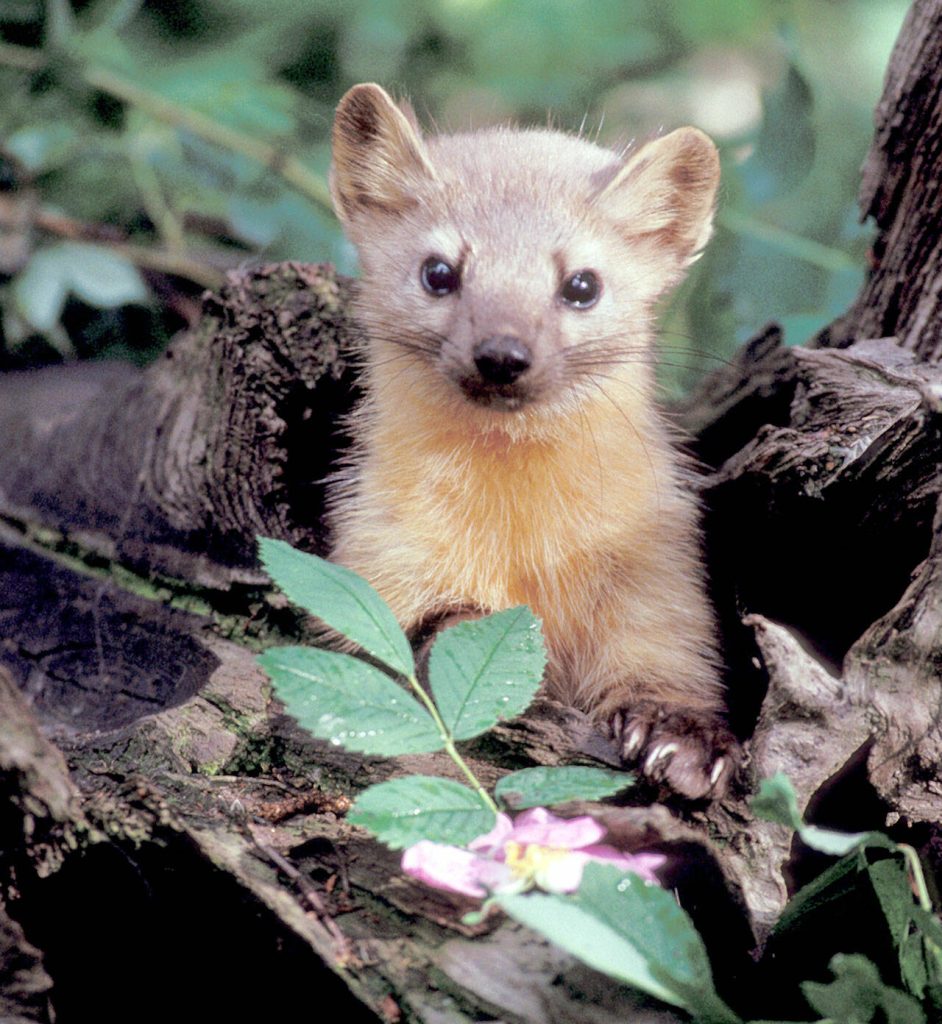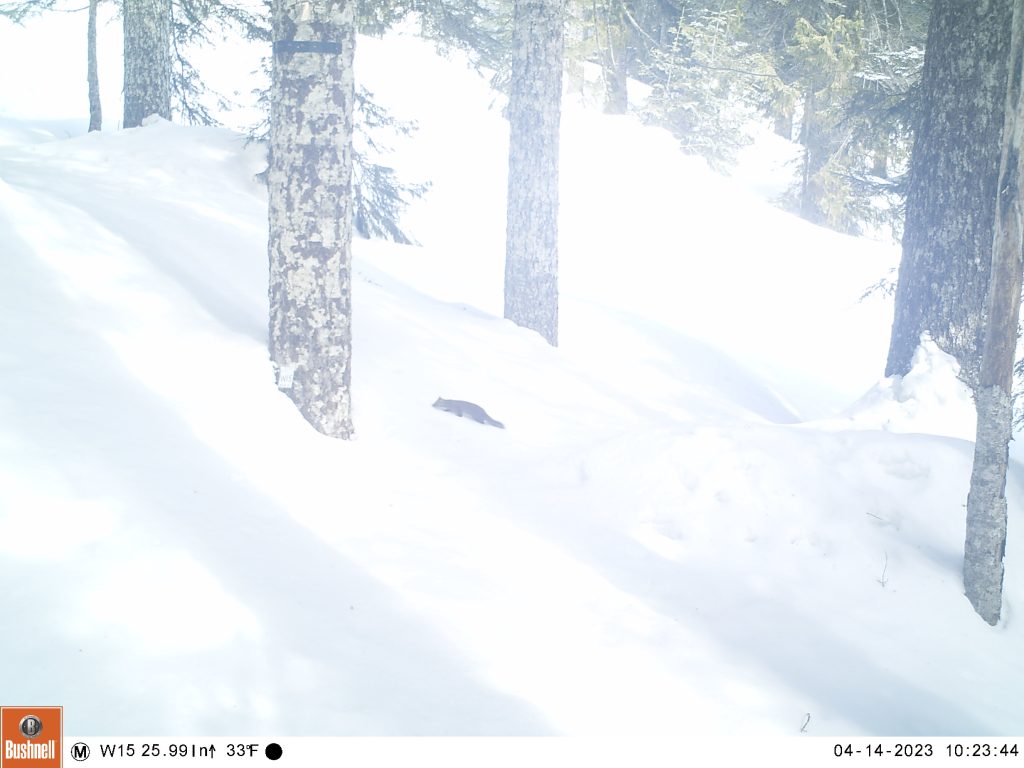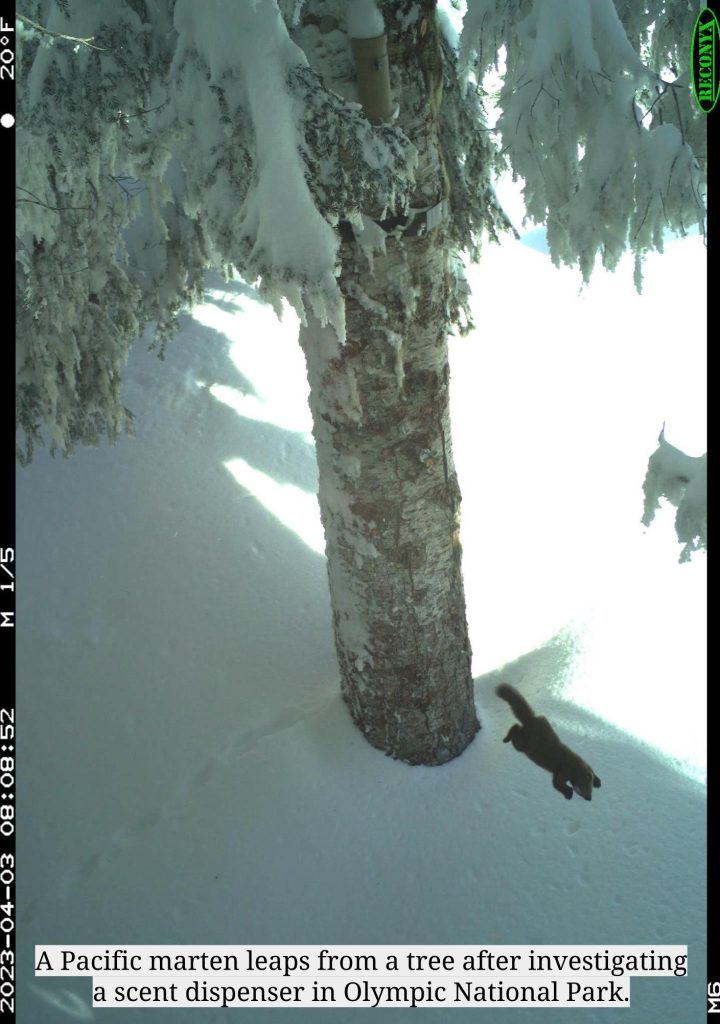August 19, 2024
Project Highlight: Assessment of Pacific marten status in Olympic National Park: Are they headed to extirpation?
By Kylie Baker
Olympic National Park, a vast wilderness of temperate rainforests, rugged mountains, and rich biodiversity, is home to many unique species. Among them is the Pacific marten (Martes caurina), a medium-sized member of the weasel family that has long inhabited the forested regions of the Pacific Northwest. However, the continued presence of the Pacific marten in the coastal regions of Washington State, particularly within Olympic National Park, is under threat, raising concerns about its potential extirpation from this area.
In 2021, a critical Pacific Northwest Cooperative Ecosystem Studies Unit (PNW CESU) research project was launched to better understand the occupancy status of Pacific martens in Olympic National Park and surrounding coastal regions. Led by Principal Investigator Aaron Wirsing and master’s student researcher Dylan Hubl from the University of Washington School of Environmental and Forest Sciences Predator Ecology Lab, this project represents the latest phase of an ongoing collaborative effort that has spanned over a decade. Since its inception in 2013-2014, the project has relied on cross-agency collaboration, beginning with the work of Betsy Howell from the U.S. Forest Service (USFS). Howell’s early efforts to investigate marten populations laid the foundation for further research in both Olympic National Park and adjacent USFS lands.
As the project progressed, the collaboration expanded to include the Woodland Park Zoo, which joined in later stages to contribute additional expertise and technological resources. The current phase of the project, while primarily funded by the National Park Service (NPS), also received critical support from all participating agencies as well as the University of Washington. This extensive collaboration highlights the importance of cross-boundary, ecosystem-wide efforts to effectively study and conserve the Pacific marten. The research spans projected marten habitats throughout the Olympic Peninsula, including both Park and Forest lands, emphasizing the integrated approach needed for species conservation.

Pacific martens were once widespread across the forested regions of the Pacific Northwest, ranging from low-elevation forests near sea level to subalpine areas on the Olympic Peninsula. However, the arrival of European settlers drastically altered forestry practices through the harvesting of old-growth forests that martens rely on for denning, resting, and protection from cold temperatures. The rapid loss of these critical habitats significantly contributed to the decline of marten populations.
Further exacerbating their decline, efforts to eradicate large carnivores like wolves and mountain lions through poisoning also impacted martens, as they were often bycatch, scavenging on poisoned carcasses. Although the value of marten pelts led to their legal trapping for fur until 2018, it is believed that no martens have been trapped on the Olympic Peninsula since the 1970s due to their rarity and the difficulty of finding them. A moratorium was officially placed on trapping martens on the Peninsula in 2021. This combination of habitat loss, increased mortality from poisoning, and historical trapping has contributed to a dramatic population decline, with only nine catches reported between 1968 and 2016. This alarming trend underscores the urgency of the current research project.
The research team is employing a variety of methods to achieve their objectives. A key component of their approach is the use of automated scent dispensers, a technology developed by Woodland Park Zoo and Microsoft. These dispensers, which are placed high in trees to avoid snow coverage and paired with trail cameras to monitor the animals visiting these sites, lure martens with a scent mixture of skunk spray, beaver caster, fish oil, anise oil, and propylene glycol (an anti-freezing agent). This method is more effective than traditional baiting and allows for year-round monitoring.

In the summer of 2022, Hubl deployed 67 survey sites across the park, which collected data until the summer of 2023. The results were sobering: only five martens were detected. Unfortunately, with such a low number of detections, the team is unable to run the planned occupancy models that would help determine habitat associations and predict marten occupancy throughout the Peninsula. However, Hubl also collected scat and hair samples, which have been sent for genetic testing. If any of these samples are confirmed to be from martens, they could provide valuable insights into the genetic health of the population and potentially explain why martens have not rebounded within the park and designated Wilderness areas despite the presence of protected old-growth forests.

The findings from this project are expected to have far-reaching implications for the conservation of Pacific martens in the Pacific Northwest. The research aims to identify where these isolated populations persist on the peninsula and to evaluate their genetic health. Previous studies, such as one conducted by the Rocky Mountain Research Lab in 2020, found that genetic samples from the Olympic Peninsula martens exhibited the lowest genetic diversity among marten populations surveyed along the West Coast. Although this study was based on a single genetic sample due to the species’ rarity, it raises concerns about genetic drift and inbreeding resulting from prolonged isolation.
The data collected will be instrumental in guiding federal, state, and tribal management strategies aimed at preserving this species. This research adds crucial evidence to previous surveys, confirming the small and isolated population of Pacific martens on the Olympic Peninsula. Ongoing monitoring and continued efforts to collect genetic samples are essential to better understand the genetic health of the population and inform future management decisions.
Similar to the reintroduction of fishers from British Columbia to the Olympic Peninsula, there is potential for augmenting the marten population with individuals from the Cascade range, which is closely related to the Olympic population. However, any such reintroduction must be carefully managed to avoid genetic swamping, which could replace the unique genetic signature of the Olympic population with that of the Cascades. Preserving the genetic heritage of the current population is paramount.
As the research progresses, the team remains focused on its mission to protect the Pacific marten from potential extirpation in Olympic National Park. The challenges are significant, but the dedication of the researchers and the support from collaborating agencies offer hope for the future of this iconic species. The outcomes of this project will not only contribute to the conservation of Pacific martens but also serve as a model for similar efforts aimed at protecting other vulnerable species in the region.